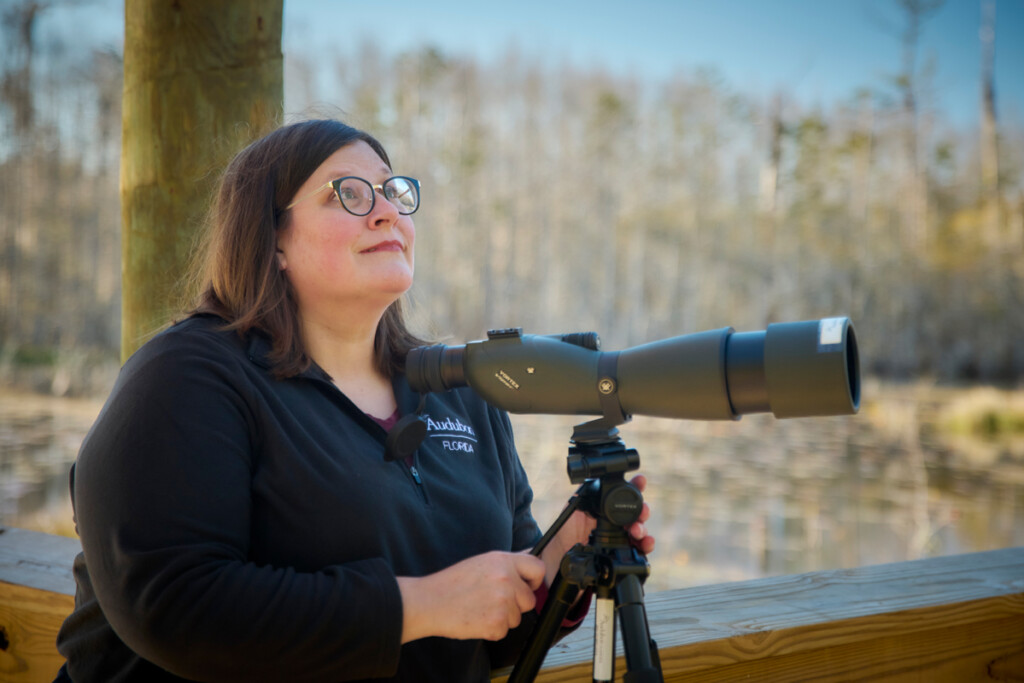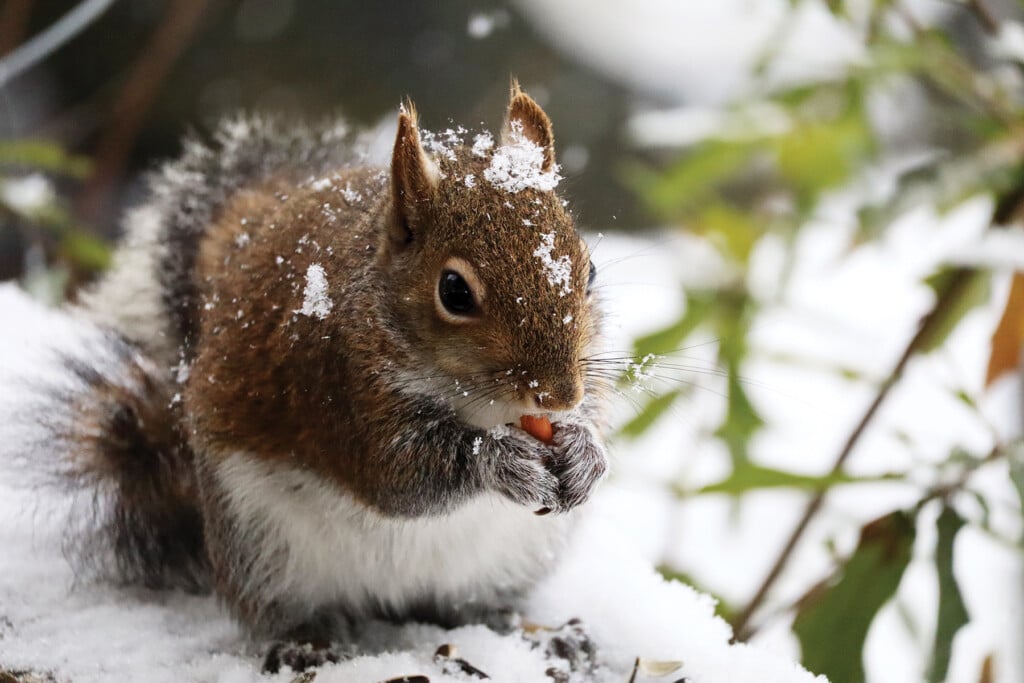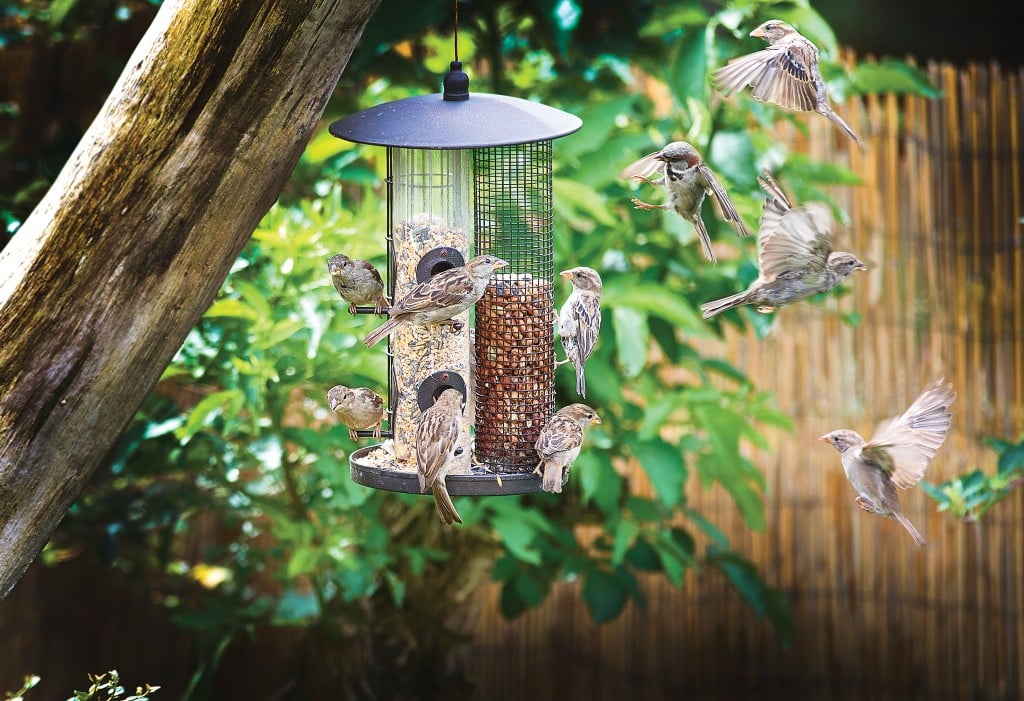Chick-a-boom
Audubon links habitat to economic health

In Florida, the growing scarcity of undisturbed beaches means that least terns, which lay their eggs on the sand, have fewer naturally occurring places to nest.
In response, the birds have gotten creative, finding that flat, gravel rooftops can serve as a workable alternative. But it’s a perilous one. Chicks sometimes fall off buildings or may get washed down gutters.
Enter concerned members of community Audubon Society chapters, who have worked to give the birds a leg up. First, noted Julie Wraithmell, the Tallahassee-based director of Audubon Florida, members determined that fallen chicks would survive and eventually fledge when returned to rooftops.
Next came the chick-a-boom.
Gaining access to attics was often a problem, so an enterprising retired orthopedic surgeon came up with a device for returning chicks to nests without entering buildings. What has come to be known as a chick-a-boom consists of a telescoping pool-tool handle; an electrical box; and a cardboard flap.
A rescuer drops a chick into the box, closes the flap, extends the pole and delivers the bird to the roof.
Chapter members have also screened downspouts and retrofitted rooftops with low fencing to contain flightless chicks.
Wraithmell concedes that the chick-a-boom is not something that a staff biologist working for Audubon Florida would have been likely to come up with. Rather, it is the kind of initiative that community chapter members often produce, given their familiarity with local issues and the diversity within their ranks.
“This was a guy who had made his living doing arthroscopic surgery,” Wraithmell said of the chick-a-boom inventor. “He was wired that way. The chapters have people who were doctors and air-conditioning techs and teachers and lawyers and everything in between. Those skills make us stronger.”

An Audubon Society chapter member has designed a device, dubbed a chick-a-boom, which is used to return chicks that fall to the ground to building tops. Photo by Wendy Meehan
Each of the 44 Audubon chapters in the state is a separate 501(c)(3) nonprofit. Four of them are located in Northwest Florida: the Francis M. Weston Audubon Society in Pensacola; the Choctawhatchee Audubon Society in Niceville; the Bay County Audubon Society in Panama City; and the Apalachee Audubon Society in Tallahassee.
“At Audubon Florida, we aren’t the boss of them, and they aren’t the boss of us,” Wraithmell said. “But we recognize that if we work together, we’ll go further.”
Audubon Florida is a state office of the National Audubon Society and the largest such office in the country. It employs just shy of 100 staffers: researchers, resource managers, educators and policy wonks.
The state office’s priorities, said Wraithmell, are water, wildlife, habitat and climate.
“Every year, our staff work with the chapters by region,” she explained. “They meet quarterly and develop regional conservation agendas. Additionally, we develop action agendas for each of our priority policy areas. All of those documents are ratified at our Audubon Assembly, which is our state conference held every October.
“It is kind of a messy structure and process, but it is an important one that gives people a voice, whether they are in the Keys or in Pensacola.”
Wraithmell joined Audubon in 2005 and has successfully led statewide conservation and wildlife policy initiatives, built Audubon Florida’s coastal conservation program, coordinated Audubon’s response to the Deepwater Horizon disaster, and helped secure millions in funding for protecting Florida’s land and water resources.

Given the growing shortage of undisturbed beaches in Florida, least terns have taken to using flat, gravel roofs as nesting sites. Photo by Jean Hall
In 2015, she was recognized with the National Audubon Society’s highest staff honor, the Charles H. Callison Award.
Wraithmell holds a bachelor’s degree in biology from Duke University and a master’s degree in geography from Florida State. Prior to joining Audubon in 2005, she worked for the Florida Fish and Wildlife Conservation Commission and, as a biological scientist, created the Great Florida Birding Trail, a statewide economic development/ecotourism amenity.
Talk to Wraithmell and she impresses you as a walking Florida gazetteer, as someone who would never get lost. Her experience blazing the birding trail may account for that. To this day, she loves Delorme topographic maps and will “nerd out” on a big atlas.
“I traveled to hundreds and hundreds and hundreds of birding spots around the state, and this was prior to GIS,” Wraithmell said. “I have crawled over most of the back 40s in Florida.”
Rely on Google Maps, and you miss out on stuff.
There was the time that Wraithmell needed to get from western Flagler County north to western St. John’s County.
“I didn’t want to drive back east to take 95 north and then go all the way back west. I looked on the DeLorme, and there was this little dotted line indicating an unpaved road,” Wraithmell said.
She took it.
“For starters, it was a healthy dirt road flanked by beautiful sand hills, but then the hills started creeping in on either side and I ended up in deep sugar sand,” Wraithmell recalled. “Then there were gigantic holes in the middle of the road. I realized there was a brick road underneath the sand, and I’m in this little rental car about the size of a skateboard, and I’m terrified that I’m going to rip the undercarriage out.
“I could not figure out what had happened. Were they bombing? Finally, when I got to the end of the road, there was a piece of cardboard tacked to a pine tree. Scribbled on it in Sharpie was STOP MINING THE BRICK OUT OF THE ROAD, A-HOLES. Google Maps never would have taken me there.”
An Avian Lens
People hear “Audubon” and invariably think about birds. Wraithmell thinks of them as the lens through which Audubon Florida works on its water, wildlife, habitat and climate priorities.
“We do very much care about birds,” she said. “They can help put a face on issues that are really technical and a yawn fest. Talk about Everglades restoration in terms of hydrology and water structures and acre feet of water, and most people’s eyes glaze over. But if you say that we lose roseate spoonbills if not enough fresh water gets to Florida Bay, suddenly people get it. We focus on ecosystems, and birds are an emblem of them.”
Wraithmell noted that Audubon, which turns 123 years old this year, was born in Florida out of the fight against the plume trade when hunters slaughtered wading birds nearly to extinction.
“That was a very grassroots effort, and much of it was led by women before they even had the right to vote,” Wraithmell said. “We’ve always been a ground-based organization, and that enables us to see where issues are emerging and where there are patterns. One chapter says, ‘Oh my gosh, I’ve seen this strange thing happening.’ Another one somewhere else reports seeing the same thing. Suddenly, we’re in a position to start connecting the dots.
“Local chapters serve as incubators and test sites where we can try solutions, and if they work, we scale them up.”

Daisy Girl Scouts in Northwest Florida have devoted proceeds from cookie sales to a campaign aimed at protecting four shore-nesting species found at area beaches: black skimmers, least terns, snowy plovers and American oystercatchers. Florida Audubon Society director Julie Wraithmell holds an oystercatcher sign like those created by Troop 101 for posting on St. George Island. The oystercatcher is easily recognized, given its striking black and white plumage and red-orange bill. Photo by Dave Barfield
Economic Bedrock
Wraithmell stresses that in Florida, quality of life and prosperity are intimately tied to the environment.
“In Florida, our environment is our economy,” she said. “That doesn’t just mean tourism. It means property values, too. In 2017, people were reneging on sales options on multimillion-dollar homes in Southwest Florida due to the harmful algal blooms the area was experiencing. People had properties as major assets, and they couldn’t sell them.”
Audubon, Wraithmell said, has always believed that science and public involvement should drive good, common-sense public policy.
“We don’t follow ideology. We follow science, and that’s really important because it makes us able to work with people at all points along the political spectrum,” she said. “The lucky thing about Florida is that conservation has been important to both parties for a long time. Governors Graham and Chiles did great things, and so did governors Martinez and Bush. That’s because Florida depends on our environment; that truth helps people cut through the noise and focus on what matters.”
Wraithmell applauds Florida’s decades-long record of habitat protection.

Flamingos scattered by Hurricane Idalia came to rest at Treasure Island, off St. Petersburg, where the bird is rarely seen. Photo by Holley Short
“We’ve had land-buying programs since the 1980s, and they have been transparent and accountable as well as being rigorous and strategic,” she said.
In addition, the state and local jurisdictions have made effective use of easements.
“Instead of buying an entire property and having it publicly owned, you may pay a landowner to cede development rights while continuing to live on it and maybe farm it subject to limits and conditions,” Wraithmell said. “We don’t have to own and manage everything. There are ways that we can use easements to help buffer the most ecologically sensitive lands.
“Easements are another tool we can use in thinking strategically about how we want Florida to look. Northwest Florida fortunately has not had the same pressure historically that the peninsula has. But it’s coming — now.”
Chapters in NW Florida
» Francis M. Weston Audubon Society
President: Jim Brady
Membership information: fmwaudubon.org
» Choctawhatchee Audubon Society
President: Dave Clausen
Membership information: choctawhatcheeaudubon.org
» Bay County Audubon Society
Presidents: Teri Floore, Brian Dusseault
Membership information: baycountyaudubon.org
» Apalachee Audubon Society
President: Kathleen Carr
Membership information: apalachee.org

